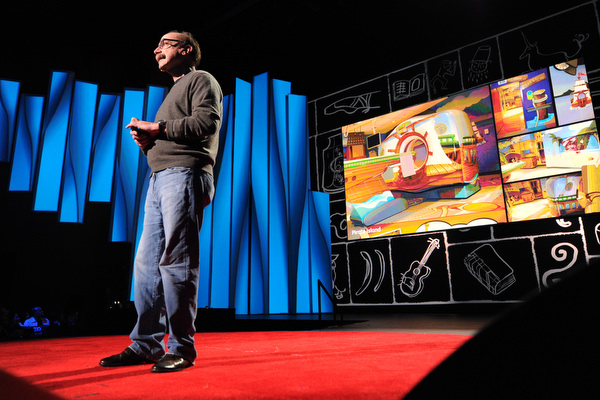Photo: James Duncan Davidson
David Kelley starts off his story in third grade, at Oakdale School in Ohio. His friend Brian was making a horse out of clay. One of the girls sitting at his table looked over and said, “that’s terrible! That’s not what a horse looks like.” Brian’s shoulders sank, he wadded up the clay and threw away his horse–and Kelley never saw him take on a project quite like that again.
This type of thing happens all the time. People often become uncomfortable around creativity — and yet surely creativity is not the domain of only a chosen few. And so, Kelley set out to understand this phenomenon and think about how he might counter it. One of his first stops: the Stanford psychologist, Albert Bandura, who developed a step-by-step process to help people overcome their phobia of snakes. An unexpected consequence of this methodical journey: overcoming fear in one domain subsequently gave people new confidence in other areas of their lives, too.
Kelley realized that such “self-efficacy” was essentially a validation of his own practice over the past 30 years. After all, much of the design process is involved with turning fear into familiarity. Now, at the d.school at Stanford, he says he sees people from all disciplines entering the program and learning a singularly useful lesson: to consider themselves as creative.
Now he tells two stories. This first is of a friend and colleague, Doug Dietz, a designer at General Electric. Dietz creates complex medical imaging equipment, including an MRI machine that is incredibly important to the medical process. But one day, Dietz saw a little girl crying, scared of the treatment she was about to receive. And whereas he’d once been proud of the lives he’d helped save, now he was disappointed to realize the fear the machine caused. And so he turned the machine into an adventure. The results were dramatic: From 80% of kids who had previously needed to be sedated, now only 10% required anesthetic. Repeating a story that has by now entered GE lore, Kelley recounts Dietz waiting with a mother for her child to come out of a scan. The little girl ran up: “mommy? Can we go again tomorrow?”
The second story is more personal. Kelley tells us the story of his own recent dealings with hospitals. Diagnosed with cancer a few years ago, he was given a less than 40% chance of survival. “But while you’re sitting around in your pajamas and everyone’s pale and thin, and you are waiting for your turn to get the gamma rays, you think about many things,” he says. “Mostly, ‘am I going to survive? What will my daughter’s life be like without me?’ But also other things: ‘what’s my calling?’ ‘What was I put on earth to do?'” And it dawned on him. “The thing I most wanted to do was help people regain the creative confidence they lost along the way. If I survived, that’s what I wanted to do. And I survived, just so you know,” he adds to laughter and applause.
Then he puts his own wish to the audience. Don’t divide the world into “creative” and “non-creative,” he urges. Let people realize they are naturally creative. “Let their ideas fly; let them achieve what Bandura calls self-efficacy,” he concludes. “When people regain that confidence, magic happens.”
See also David Kelley’s 2002 TED Talk on the importance of human-centered design.

Comments (16)
Pingback: David Kelley | DeInno
Pingback: Stanford Crash Course on Creativity – Creative Story Telling – Week 7 | Creativityland
Pingback: Curiosity and Creativity the Nuru R&D Program Begins | Nuru International
Pingback: Touching the Creative Snake « Beautiful Lofty Things
Pingback: Touching the Creative Snake « Anna Alexander Freelance
Pingback: Self Confidence – Part 2 | Ericschneiderr's Blog
Pingback: GetGeeky » The Good Stuff: Be More Interesting, FacebookIPO, Get Creative, Forget Paying for an MBA and iPhone4s Camera
Pingback: Nail guns and creativity | idiology
Pingback: On Being Made Durable for Living and Suited for Glory | 843 acres
Pingback: Building Creative Confidence and a Culture of Innovation « helichrysums
Pingback: Tom Kelley, cofundador de IDEO, llevará #NASF a su próximo libro
Pingback: Tom Kelley, cofundador de IDEO, contará la experiencia #NASF en su próximo libro
Pingback: The role of self-efficacy in creative solutions « It is only human
Pingback: Designing for function alone vs designing the entire experience @ CJ Page